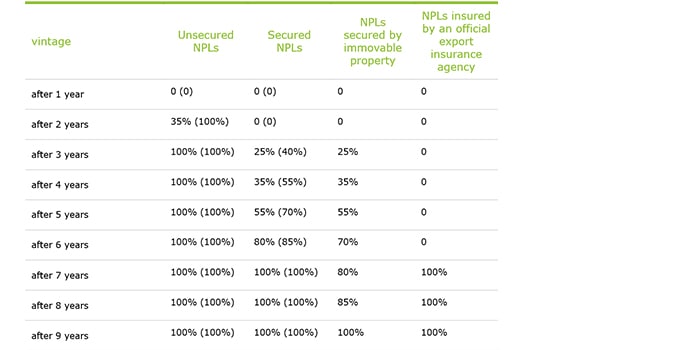Article

Minimum loss coverage for non-performing exposures
NPL backstops adopted
Publication of Regulation (EU) 2019/630 in the Official Journal of the European Union on 25 April 2019, entry into force and application on 26 April 2019
During its plenary session on 14 March 2019, the European Parliament approved the preliminary outcome of the interinstitutional negotiations published on 7 January 2019 (trilogue negotiations; ECON_AG(2019)632943) with regard to minimum loss coverage for non-performing exposures (NPL backstops) (P8_TA-PROV(2019)0208) at first reading – the Council adopted on 9 April 2019. The new regulation will enter into force one day after their publication in the Official Journal of the European Union, on 26 April 2019, and immediately apply to all exposures that have been newly originated or modified in a way that increases the institution’s exposure and have been subsequently classified as non-performing.
This concludes a one-year negotiation period and an important NPL action plan on dealing with non-performing loans is finally being implemented for the future.
In earlier articles, we reported on the details of the draft originally submitted by the EU Commission and the other amendments debated (e.g. see NPL: Introduction of prudential provisioning backstops in 12/2018).
In contrast to the final report by the Committee on Economic and Monetary Affairs (A8-0440/2018) presented in December 2018, the result of the trilogue negotiations and the wording now adopted include further changes to the multiplication factors used to calculate the level of minimum loss coverage requirements. The factors finally presented lead to premature or higher minimum loss coverage requirements and, in the event of insufficient risk provisioning, to greater deductions from the banks’ common equity tier (CET) 1 capital. In return, exceptions were granted in the form of lower multiplication factors for loans secured by immovable properties or loans guaranteed by official export insurance agencies. Even loans that have been granted a forbearance measure for the first time will benefit from this measure in the subsequent year because the factor applicable until then will be used for a further year instead of the higher factor in the next vintage phase. The article we wrote in conjunction with the German Savings Banks Association (DSGV) uses a case study to explain the backstop procedure (see Applying the Backstop Procedure in Betriebswirtschaftliche Blätter on 24 September 2018).
The following table shows a comparison of the multiplication factors to be applied in each case based on the NPL classification’s vintage. For unsecured non-performing exposures, a minimum coverage of 35% is required after two years, i.e. from the first day of the third year after their classification as non-performing. After three years, i.e. from the beginning of the fourth year, unsecured NPLs must be fully covered. After three years at the earliest, one quarter of secured non-performing exposures must be fully covered and after nine years at the latest. We’ve placed the factors listed by the ECB in its March 2018 addendum to the NPL guidance (see: Minimum provisioning requirements for NPL) and which are to be fulfilled by the banks directly supervised by the ECB under the SSM in brackets after the factors of the newly introduced Article 47c CRR in order to make a direct comparison possible.
The introduction of prudential provisioning backstops for non-performing loans is a measure for the future that only covers loans that will soon be newly originated and classified as non-performing and will lead to the (voluntary) formation of risk provisions after two or three years at the earliest or, alternatively, to a deduction from the CET 1 capital in the form of a prudential backstop for non-performing exposures. The purpose is to prevent a large number of NPLs from amassing in the future. This measure applies to all banks in the EU equally and to banks active in the secondary market (the schedule above also applies to purchased NPLs and from the date of the original NPL classification, not the date of purchase). In certain cases, the competent authorities may go beyond the requirements outlined in order to ensure sufficient loss coverage for non-performing exposures.
Critics complain that the large number of non-performing loans accumulated by EU banks during the financial and economic crisis, which endanger banking and financial stability in the Euro zone, is not covered by this law at all.
The Action Plan on Reducing Non-performing Loans in Europe provides for further measures in addition to the introduction of the final regulatory guarantee for non-performing loans in order to reduce the large number of NPLs that already exist in the EU. In addition to the proposals for defining the conditions for creating an active secondary market (draft directive on credit service providers, credit buyers and the realisation of collateral (2018/0063 (COD)), which continue to be the subject of debate, efforts are being made to process current NPLs individually and based on the bank’s respective business model.
The initiation of the deduction for non-performing loans, which has now been decided, is part of amendments to the CRR, in particular the introduction of Article 47c. Considering the potentially rapid adoption into European law, users should get to grips with these developments as soon as possible. Furthermore, the slightly different prudential provisioning backstops from the ECB – in terms of the banks that are supervised as part of the SSM – and which were finalised in March 2018, must be included in any deliberations.
Your Contacts
Andrea Flunker
aflunker@deloitte.de
Tel: +49 211 8772 3823
Dr. Tanja Schlösser
tschloesser@deloitte.de
Tel: +49 211 8772 2169
Auch interessant
NPL: Einführung von Risikovorsorge-Backstops
EU kurz vor dem Ziel?
Any progress on European NPLs?
Yes indeed, says new EU Commission Report



